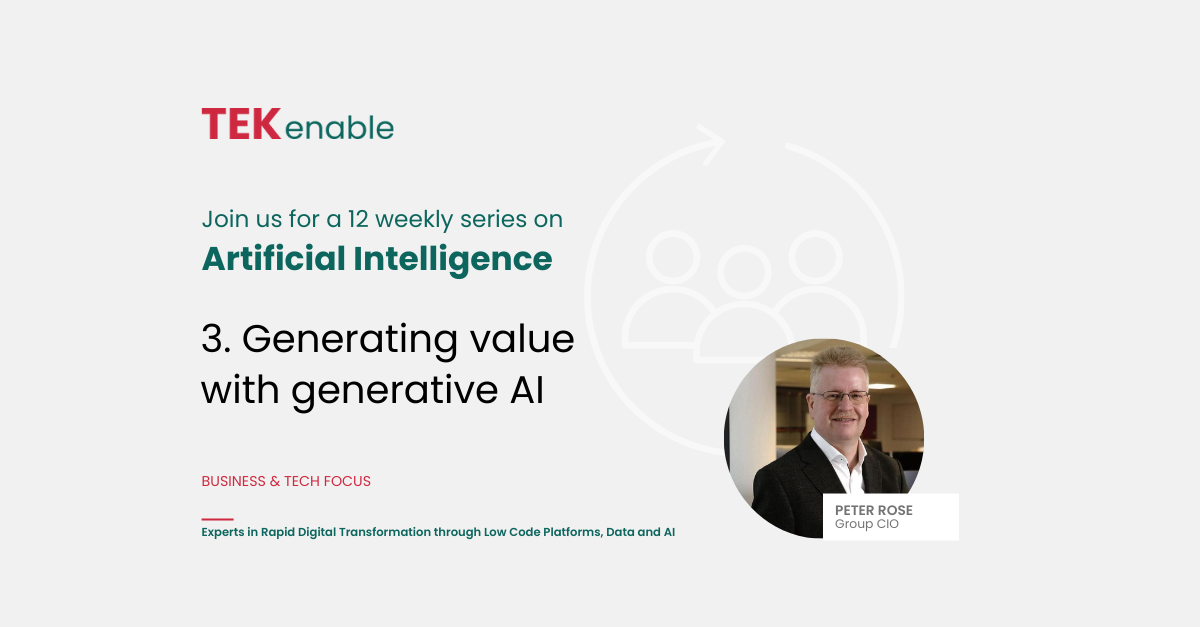Generative AI is a branch of artificial intelligence that can create new content, such as images, text, music and code. But how does it work – and how can it be used to generate value for businesses and their customers?
In the second in his five-part series of articles on the business applications of artificial intelligence, TEKenable group chief technology officer Peter Rose takes a deep dive into generative AI, exploring how the technology works and presenting a series of business cases for its use, including in finance, healthcare and government.
Artificial intelligence (AI) is not only about analysing data and making decisions. It can also be used to create new data and content to enhance human creativity and innovation. As I outlined last week, there is a wide array of forms of AI, from machine learning (ML) to deep learning. However, the form that has caught everyone’s attention, and rightly so, is generative AI.
So just what, precisely, is generative AI? The answer is in the name: generative AI is a type of artificial intelligence that can use data to create, or ‘generate’, new content, be that text, images, or even music. Crucially, the content that it generates is novel, meaning that while it is derived from the supplied data, it is not part of it. In other words, generative AI does not just sort and repeat data, instead it uses data to create entirely new things.
In a nutshell, generative AI works by training a machine learning model on a large dataset of existing content. The model learns to identify patterns in the data and then uses those patterns to generate new content that is similar, but not identical, to the data it was trained on.
Few people reading this will be unaware of ChatGPT, the generative AI chatbot created by OpenAI. ChatGPT responds to user queries, creating answers to questions in natural language. As a result, ChatGPT and similar generative AIs such as Google’s Bard have unleashed a wave of excitement and fear about the capability of computers to perform tasks once vouchsafed for humans.
And, really, there is no denying that the first time you ask a computer a question and have it respond, correctly, in plain English is an extraordinary experience. However, given businesses are unlikely to hand tasks such as content creation or decision making over to a machine, what do publicly-available chatbots tell us about potential uses for AI?
It may even be tempting to think ‘so far, so good, so what?’, but AI is more than a parlour trick. Fun as it is to chat with Microsoft’s talkative new Bing chatbot, have Stable Diffusion create digital paintings, or get ChatGPT to explain concepts, the real value of generative AI is found in what it can do with data.
How does Generative AI work?
Like any sub-field in technology, AI is laden with jargon. However, as generative AI is relatively new, it has thrown up particularly unfamiliar terms that can act as an impediment to developing a deep understanding of how it works. Most people have now heard of large language models (LLMs), but what about transformers? Or generative adversarial networks (GANs)? Or variational autoencoders (VAEs)?
Clearly some definitions are in order:
- LLMs are deep learning algorithms that can recognise, summarise, translate, predict, and generate content using very large datasets. They are a form of what is called a ‘transformer model’ neural network that learns context and, as a result, meaning by tracking relationships in sequential data (such as the words in a sentence like this).
When we speak of generative AIs, this is typically, though not always, what we mean. With an LLM transformer, a user ‘prompts’ (poses a question to) the application, which then turns to its dataset and uses it to generate a response. The ‘large language’ part of large language model simply means that the model is trained on a very large amount of text data (usually from the internet, though as I will outline below this will not be the case with most business applications), and the fact that it can process and generate a very large vocabulary of words, phrases and sentences.
- A GAN, or generative adversarial network, on the other hand, is an AI model where two neural networks are set against each other in something akin to a game. One network, the generator, creates new data, while the other network, the discriminator, attempts to determine if the newly-created data is correct or incorrect.
- A variational autoencoder (VAE) generates new data that is similar to the data it was trained on. It does this by attempting to discover ‘latent representation’ in data, which is to say a hidden or unobserved variable that encapsulates the essential features of the data.
GANs, VAEs and transformers, including LLMs, are all types of what is known as a ‘foundation model’, the artificial neural networks that can learn to produce new and realistic output, such as images, text, music, and computer code, based on user input or some other criteria.
Obviously, the above is still fairly complex, but it should give a clearer understanding of how generative AIs, of various sorts, can create new content from the data they have been provided with. Hopefully, it has also spurred some thoughts on the matter at hand: what can generative AIs do for me?
The business uses for generative AI
Generative AI is a rapidly growing field with a wide range of potential applications in business. Indeed, at TEKenable, we have already launched a major generative AI-based product called ‘Chat With Your Documents’.
This is not a sales pitch, though; rather it is an example intended to demonstrate a practical application for generative AI. Chat With Your Documents aims to solve a real business problem: documentation. Every research report, sales proposal, strategy, product or project document contains valuable institutional knowledge. This knowledge is easily lost, something that progressively gets worse as people leave or change jobs.
Chat With Your Documents stops this from happening by using generative AI to search these documents, which are effectively unstructured data, and synthesise new information from it. For example it can summarise information, combine it with information found in other documents, and even translate it into other languages. Users simply prompt the application and it will create an answer based on the documents it has been given access to.
Clearly, this is not done on the public internet. Unlike chatbots such as ChatGPT, Bing and Bard, Chat With Your Documents is deployed on a company’s data inside Microsoft Azure. This is essential in order to remain compliant with data protection regulations and it also protects company intellectual property from leaking onto the internet or being used to train a public AI model.
The applications for generative AI do not end there, though. As proud as we are of Chat With Your Documents, it is a relatively early application of generative AI for business use.
We foresee a lot more to come, including very dramatic applications in specific verticals:One of the most exciting potential applications for AI in general is in healthcare. For example, TEKenable has already deployed machine learning to look at patient groups and then automatically vary treatment according to results. ML is also already used to analyse medical images during the diagnostic process. Generative AI is likely to have an even more significant impact, though, from diagnosis to treatment and in patient management.
Key applications include:
- Anticipating and adapting to patient flow, including in the context of rapidly changing circumstances, such as during an emergency, natural disaster or as we saw during the Covid-19 pandemic
- Developing personalised treatments for patients, based on their individual medical histories and needs, thus improving the efficacy of treatments and reducing the risk of side effects
- Generating synthetic medical data to train machine learning models
- Developing new drugs and therapies, accelerating the drug discovery process and improving the chances of finding new treatments for diseases
- Creating virtual assistants for healthcare providers to help with tasks such as scheduling appointments, managing patient records, and providing information.
Financial services, too, will be upended by the application of generative AI. Again, using machine intelligence is not entirely new in this sector.
Algorithmic trading has been in existence since the 1970s, for example, and actuarial tables are nothing if not data.
In fact, the possibilities are so significant that TEKenable has published a white paper on the uses of AI in the modernisation of financial services IT systems.
The key applications we foresee for generative AI in financial services are: augmenting human decision-making in areas such as financing and underwriting, coding and development as part of IT modernisation, and extracting information from data for a variety of purposes:
- Detecting fraud and financial crime by identifying indicative patterns in data
- Speeding actuarial and loan decision-making
- Assisting in underwriting and claims management
- Creating personalised financial products and services tailored to the specific needs of a customer, or optimising investment portfolios by identifying the best mix of assets to achieve a specific goal
- Personalising customer experiences to provide information and services tailored to individual needs
- Modelling market and other financial data
Generative AI will have a major impact in the public service, too. Naturally, there is significant overlap between public service and healthcare, but that aside, a wide array of government, state and local authority services and processes can be augmented, improved and sped up with AI.
- Planning and managing infrastructure, such as roads, public transport, bridges and tunnels, and public buildings, including by analysing spatial and demographic data, in order to improve the efficiency and sustainability of these assets
- Personalising services for citizens to ensure that services meet individual needs, including by making citizens aware of available services they are not already using
- Detecting fraud and abuse with the aim of protecting public resources and ensuring that services are delivered to those who need them most.
- Predicting and responding to natural disasters, such as floods, earthquakes, and wildfires, including managing spatial information and emergency response, as well as scenario simulation
- Generating synthetic data to train machine learning models to improve public services including transportation, healthcare, and education
- Overcoming language barriers with immigrant and refugee populations through machine translation and live interpreting
Hopefully, this article has given you a sense of how AI can create value for your business or at least how we are only beginning to feel its transformative effects. There is a lot more to AI than customer service chatbots!
In the next article in this series, I will look at the thorny issue of ethics and AI, from compliance to bias.





